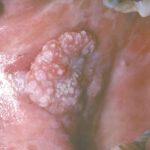
Oral proliferative verrucous leukoplakia is one of a group of oral potentially malignant disorders (OPMDs) considered to have a strong tendency for malignant transformation.
The aim of this review was to investigate the available evidence on the malignant transformation of oral proliferative verrucous leukoplakia.
Methods
Searches were conducted in the Cochrane Library, Embase, Latin American and Caribbean Health Sciences [LILACS], Medline/PubMed, Scopus, Web of Science, Google Scholar, Open Grey, and ProQuest databases with no date or language restrictions. Studies investigating malignant transformation in individuals diagnosed by clinical and/or histopathological assessment with oral proliferative verrucous leukoplakia were considered. two reviewers independently selected studies extracted data and assessed risk of bias using Joanna Briggs Institute critical appraisal tools. The main outcome was pooled proportion of malignant transformation of oral proliferative verrucous leukoplakia.
Results
- 17 cohort studies (1 prospective,16 retrospective) involving 474 patients were included.
- 9 studies were from Europe, 5 from America and 3 from Asia.
- 4 studies were considered to be at low risk of bias, 9 at moderate risk and 4 at high risk.
- The gingiva (39.6%) and buccal mucosa (21.6%) were the most frequent affected sites.
- Of the 474 patients diagnosed with oral proliferative verrucous leukoplakia 221 (44.5%) underwent malignant transformation.
- Meta-analysis (17 studies) showed overall malignant transformation = 43.7% (95%CI; 31.93% to 56.16%).
- Other analyses looked at malignant transformation in different geographies and gender.
| % Malignant transformation (95%CI) | |
| Europe | 45.2% (29.9% to 60.9%) |
| America | 57.8% (40.6% to 74.2%) |
| Asia | 15.67% (1.46% to 36.8%); |
| Females | 40.26% (30.6% to 50.3%) |
| Males | 28.80% (19.14% to 39.2%) |
Conclusions
The authors concluded: –
..the pooled malignant transformation (MT) proportion of oral proliferative verrucous leukoplakia (PVL) was 43.87% (95% CI = 31.93–56.13). PVL was more frequently reported in females than males, and the mean age of patients was higher than 50 years in most studies. In addition, gingiva and buccal mucosa were most commonly affected by PVL, and gingiva was the most reported site of MT. No clear association was found between MT of PVL and sex, age, geographic location, and tobacco or alcohol consumption.
Comments
Previously we have looked at reviews of malignant transformation in oral leukoplakia in general with the most recent (Dental Elf – 25th Jun 2021) providing a pooled proportion of malignant transformation = 9.8% (95%CI; 7.9 to 11.7%). This new review focusses on oral proliferative verrucous leukoplakia. While 17 studies are included all but one is retrospective, and they are generally small with sample sizes ranging from 3 to 81 (average 28.9). The review authors also highlight the absence of diagnostic criteria for oral proliferative verrucous leukoplakia, short follow up periods and little information on follow periods and drop put rates. Consequently, the overall estimate for malignant transformation of 43.87% (95% CI; 31.93 to 56.13) should be viewed cautiously although the review indicated that it is much higher than the rate for oral leukoplakia in general. Future studies on this topic should be prospective and follow the recommendations outline in the STROBE checklist.
Links
Primary Paper
Ramos-García P, González-Moles MÁ, Mello FW, Bagan JV, Warnakulasuriya S. Malignant transformation of oral proliferative verrucous leukoplakia: A systematic review and meta-analysis. Oral Dis. 2021 May 19. doi: 10.1111/odi.13831. Epub ahead of print. PMID: 34009718.
Other references
Dental Elf – 29th May 2020
Oral Proliferative Verrucous Leukoplakia: What are the clinical features?
Dental Elf – 25th Jun 2021
Picture Credits
By Aitor III – Own work, Public Domain, Link
